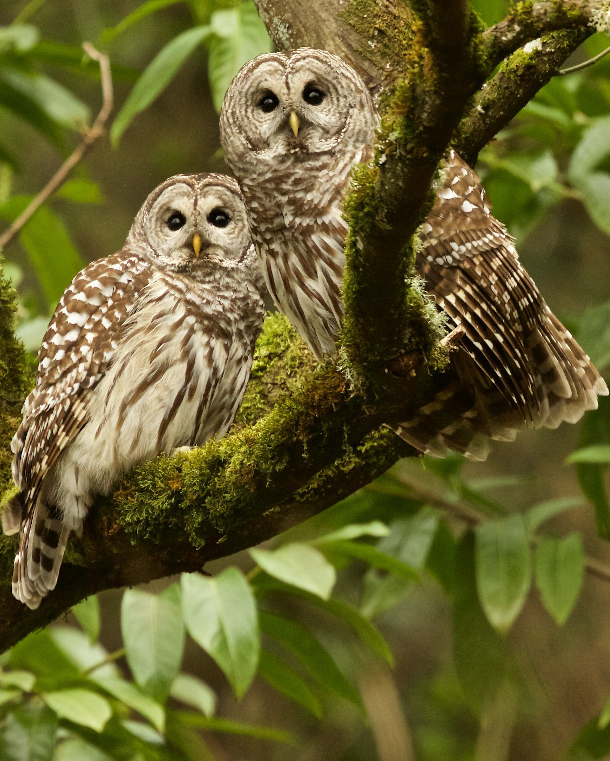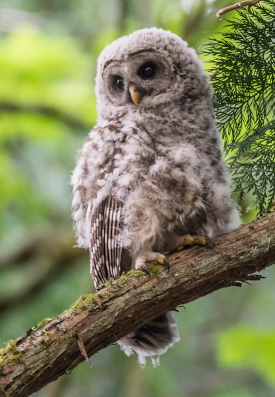BirdNote®: Here Come the Barred Owls
Air Date: Week of February 12, 2021

A pair of Barred Owls in a lush forest (Photo: © Gregg Thompson)
Barred Owls are among the most vocal owls in North America and one of the easiest birds for humans to imitate. BirdNote®’s Mary McCann shares some of the Barred Owl’s signature calls and what could be enabling the bird to expand its range West.
Transcript
BASCOMB: One of the easiest birds for humans to imitate might very well be the barred owl. BirdNote’s Mary McCann has more.
BirdNote®
Here Come the Barred Owls
[Typical hoot sequence of a pair of Barred Owls] The emphatic hoots of a pair of Barred Owls resonate in the still of a February night.
[Typical hoot sequence of a pair of Barred Owls]
So-called for the stripes on their breast, Barred Owls are among the largest owls in North America. They're also the most vocal. Their signature hooting sequence has been memorably described as “who-cooks-for-you?! who-cooks-for-you-all?!”
[Typical hoot sequence of a pair of Barred Owls] But this is just one of more than a dozen Barred Owl calls, ranging from a “siren call” to a “wail” to a wonderfully entertaining “monkey call.”

Barred Owlet in Seattle. The species is relatively new to the West and is now competing with the northern spotted owl. (Photo: sunrisesoup, Flickr CC BY-NC-ND 2.0)
[Barred Owl monkey call] Although the Barred Owl’s calls have long been heard in Eastern forests, it is a relative newcomer to the western US. During the 20th Century, its breeding range has expanded into the North and the West, and down as far as northern California. The exact reasons behind the expansion aren't certain. But new riparian forests, fire suppression, and the planting of shelter-belts in the northern Great Plains are some of the human impacts that have likely played a role. No matter what accounts for the Barred Owl’s dramatic sweep across the continent, the bird – and its extraordinary voice – seem here to stay.
[Barred Owl “monkey call”]
###
###
Written by Bob Sundstrom
Call of the Barred Owl provided by The Macaulay Library of Natural Sounds at the Cornell Lab of Orni-thology, Ithaca, New York. Barred Owl [105433] recorded by G.A. Keller
BirdNote's theme music was composed and played by Nancy Rumbel and John Kessler
Producer: John Kessler
Executive Producer: Dominic Black
© 2015 Tune In to Nature.org February 2017/2019/2021 Narrator: Mary McCann
ID# 022607BADO2 BADO-01b
https://www.birdnote.org/listen/shows/here-come-barred-owls
Links
Find this story and more on the BirdNote® website
Learn more about the Barred Owl at All About Birds
More on the Barred Owl at Audubon’s Field Guide to North American Birds
Living on Earth wants to hear from you!
Living on Earth
62 Calef Highway, Suite 212
Lee, NH 03861
Telephone: 617-287-4121
E-mail: comments@loe.org
Newsletter [Click here]
Donate to Living on Earth!
Living on Earth is an independent media program and relies entirely on contributions from listeners and institutions supporting public service. Please donate now to preserve an independent environmental voice.
NewsletterLiving on Earth offers a weekly delivery of the show's rundown to your mailbox. Sign up for our newsletter today!
 Sailors For The Sea: Be the change you want to sea.
Sailors For The Sea: Be the change you want to sea.
 The Grantham Foundation for the Protection of the Environment: Committed to protecting and improving the health of the global environment.
The Grantham Foundation for the Protection of the Environment: Committed to protecting and improving the health of the global environment.
 Contribute to Living on Earth and receive, as our gift to you, an archival print of one of Mark Seth Lender's extraordinary wildlife photographs. Follow the link to see Mark's current collection of photographs.
Contribute to Living on Earth and receive, as our gift to you, an archival print of one of Mark Seth Lender's extraordinary wildlife photographs. Follow the link to see Mark's current collection of photographs.
 Buy a signed copy of Mark Seth Lender's book Smeagull the Seagull & support Living on Earth
Buy a signed copy of Mark Seth Lender's book Smeagull the Seagull & support Living on Earth

